Magnetism and Thermal Transport of Exchange-Spring-Coupled La2/3Sr1/3MnO3/La2MnCoO6 Superlattices with Perpendicular Magnetic Anisotropy
Abstract
:1. Introduction
2. Materials and Methods
2.1. Sample Preparation and Characterization
2.2. Measurements of Thermal Conductivity by the 3ω Method
3. Results and Discussion
3.1. Structure and Microstructure of LSMO/LMCO Superlattices
3.2. Magnetic Exchange Spring in LSMO/LMCO Superlattices
3.3. Magneto-Thermal Conductivity of LSMO/LMCO SL
4. Conclusions
Supplementary Materials
Author Contributions
Funding
Data Availability Statement
Acknowledgments
Conflicts of Interest
References
- Tokura, Y.; Tomioka, Y. Colossal magnetoresistive manganites. J. Magn. Magnet. Mater. 1999, 200, 1–23. [Google Scholar] [CrossRef]
- Kobayashi, K.-I.; Kimura, T.; Sawada, H.; Terakura, K.; Tokura, Y. Room-temperature magnetoresistance in an oxide material with an ordered double-perovskite structure. Nature 1998, 395, 677. [Google Scholar] [CrossRef]
- Salamon, M.B.; Jaime, M. The physics of manganites: Structure and transport. Rev. Mod. Phys. 2001, 73, 583. [Google Scholar] [CrossRef]
- Chahara, K.; Ohno, T.; Kasai, M.; Kozono, Y. Magnetoresistance in magnetic manganese oxide with intrinsic antiferromagnetic spin structure. Appl. Phys. Lett. 1993, 63, 1990. [Google Scholar] [CrossRef]
- von Helmolt, R.; Wecker, J.; Holzapfel, B.; Schultz, L.; Samwer, K. Giant negative magnetoresistance in perovskite-like La2/3Ba1/3MnOx ferromagnetic films. Phys. Rev. Lett. 1993, 71, 2331. [Google Scholar] [CrossRef] [PubMed]
- Volkov, N.A. Spintronics: Manganite-based magnetic tunnel structures. Phys.-Usp. 2012, 55, 250. [Google Scholar] [CrossRef]
- Khomskii, D.I. Multiferroics: Different ways to combine magnetism and ferroelectricity. J. Magn. Magnet. Mater. 2006, 306, 1–8. [Google Scholar] [CrossRef]
- Zhang, M.; Jeerh, G.; Zou, P.; Lan, R.; Wang, M.; Wang, H.; Tao, S. Recent development of perovskite oxide-based electrocatalysts and their applications in low to intermediate temperature electrochemical devices. Mater. Today 2021, 49, 351. [Google Scholar] [CrossRef]
- Ghosh, S.; Shankar, H.; Kar, P. Recent developments of lead-free halide double perovskites: A new superstar in the optoelectronic field. Mater. Adv. 2022, 3, 3742. [Google Scholar] [CrossRef]
- Wang, H.; Su, W.; Liu, J.; Wang, C. Recent development of n-type perovskite thermoelectrics. J. Mater. 2016, 2, 225. [Google Scholar] [CrossRef]
- Hwang, H.Y.; Iwasa, Y.; Kawasaki, M.; Keimer, B.; Nagaosa, N.; Tokura, Y. Emergent phenomena at oxide interfaces. Nat. Mater. 2012, 11, 103. [Google Scholar] [CrossRef] [PubMed]
- Hellman, F.; Hoffmann, A.; Tserkovnyak, Y.; Beach, G.S.D.; Fullerton, E.E.; Leighton, C.; MacDonald, A.H.; Ralph, D.C.; Arena, D.A.; Dürr, H.A.; et al. Interface-induced phenomena in magnetism. Rev. Mod. Phys. 2017, 89, 025006. [Google Scholar] [CrossRef] [PubMed]
- Moshnyaga, V.; Samwer, K. Polaronic Emergent Phases in Manganite-Based Heterostructures. Crystals 2019, 9, 489. [Google Scholar] [CrossRef]
- Xu, Y.; Awschalom, D.D.; Nitta, J. Handbook of Spintronics; Springer: Dortrecht, The Netherland, 2015. [Google Scholar]
- Berger, A.; Supper, N.; Ikeda, Y.; Lengsfield, B.; Moser, A.; Fullerton, E.E. Improved media performance in optimally coupled exchange spring layer media. Appl. Phys. Lett. 2008, 93, 122502. [Google Scholar] [CrossRef]
- Kwon, C.; Robson, M.C.; Kim, K.-C.; Gu, J.Y.; Lofland, S.E.; Bhagat, S.M.; Trajanovic, Z.; Rajeswari, M.; Venkatesan, T.; Kratz, A.R.; et al. Stress-induced effects in epitaxial (La0.7Sr0.3)MnO3 films. J. Magn. Magn. Mater. 1997, 172, 229. [Google Scholar] [CrossRef]
- Wang, Z.-H.; Cristiani, G.; Habermeier, H.-U.; Zhang, Z.-R.; Han, B.-S. Perpendicular magnetic anisotropy of La0.67Sr0.33MnO3 thin films grown on CaMnO3 buffered SrTiO3. J. Appl. Phys. 2003, 94, 5417. [Google Scholar] [CrossRef]
- Zhang, Z.; Guan, X.; Shen, X.; Zhang, J.; Han, F.; Zhang, H.; Zhang, H.; Yan, X.; Zhang, Q.; Gu, L.; et al. Symmetry mismatch-driven perpendicular magnetic anisotropy for perovskite/brownmillerite heterostructures. Nat. Commun. 2018, 9, 1923. [Google Scholar] [CrossRef]
- Xiao, Z.; Zhang, F.; Farrukh, M.A.; Wang, R.; Zhou, G.; Quan, Z.; Xu, X. Perpendicular magnetic anisotropy in compressive strained La0.67Sr0.33MnO3 films. J. Mater. Sci. 2019, 54, 9017. [Google Scholar] [CrossRef]
- Thórarinsdóttir, K.A.; Hase, T.; Hjörvarsson, B.; Magnus, F. Amorphous exchange-spring magnets with crossed perpendicular and in-plane anisotropies. Phys. Rev. B 2021, 103, 014440. [Google Scholar] [CrossRef]
- Wüchner, A.; Voiron, J.; Toussaint, J.C.; Préjean, J.J. Observation and computer simulation of magnetization processes in exchange-coupled Sm-Co/Co-Zr/Sm-Co’ sandwiches. J. Magn. Magn. Mater. 1995, 148, 264. [Google Scholar] [CrossRef]
- Fullerton, E.E.; Jiang, J.S.; Bader, S.D. Hard/soft magnetic heterostructures: Model exchange-spring magnets. J. Magn. Magn. Mater. 1999, 200, 392. [Google Scholar] [CrossRef]
- Jiang, J.S.; Bader, S.D. Magnetic reversal in thin film exchange-spring magnets. Scr. Mater. 2002, 47, 563. [Google Scholar] [CrossRef]
- Kneller, E.F.; Hawig, R. The exchange-spring magnet: A new material principle for permanent magnets. IEEE Trans. Magn. 1991, 27, 3588. [Google Scholar] [CrossRef]
- Das, S.; Rata, A.D.; Maznichenko, I.V.; Agrestini, S.; Pippel, E.; Gauquelin, N.; Verbeeck, J.; Chen, K.; Valvidares, S.M.; Vasili, H.B.; et al. Low-field switching of noncollinear spin texture at La0.7Sr0.3MnO3-SrRuO3 interfaces. Phys. Rev. B 2019, 99, 024416. [Google Scholar] [CrossRef]
- Mibu, K.; Nagahama, T.; Shinjo, T.; Ono, T. Magnetoresistance of Bloch-wall-type magnetic structures induced in NiFe/CoSm exchange-spring bilayers. Phys. Rev. B 1998, 58, 6442. [Google Scholar] [CrossRef]
- Revathy, R.; Kalarikkal, N.; Varma, M.R.; Surendran, K.P. Exchange-spring mechanism and Griffiths-like phase in room-temperature magnetoelectric Ni–BaTiO3 composites. Mater. Adv. 2021, 2, 4702. [Google Scholar] [CrossRef]
- Orfila, G.; Sanchez-Manzano, D.; Arora, A.; Cuellar, F.; Ruiz-Gómez, S.; Rodriguez-Corvillo, S.; López, S.; Peralta, A.; Carreira, S.J.; Gallego, F.; et al. Large Magnetoresistance of Isolated Domain Walls in La2/3Sr1/3MnO3 Nanowires. Adv. Mater. 2023, 35, 2211176. [Google Scholar] [CrossRef]
- Franz, R.; Wiedemann, G. Ueber die Wärme-Leitungsfähigkeit der Metalle. Ann. Phys. Chem. 1853, 165, 497. [Google Scholar] [CrossRef]
- Thesberg, M.; Kosina, H.; Neophytou, N. On the Lorenz number of multiband materials. Phys. Rev. B 2017, 95, 125206. [Google Scholar] [CrossRef]
- Chen, B.; Rojo, A.G.; Uher, C.; Ju, H.L.; Greene, R.L. Magnetothermal conductivity of La0.8Ca0.2MnO3. Phys. Rev. B 1997, 55, 15471. [Google Scholar] [CrossRef]
- Maheswar Repaka, D.V.; Mahendiran, R. Giant magnetothermopower in charge ordered Nd0.75N0.25MnO3. Appl. Phys. Lett. 2013, 103, 162408. [Google Scholar] [CrossRef]
- Visser, D.W.; Ramirez, A.P.; Subramanian, M.A. Thermal Conductivity of Manganite Perovskites: Colossal Magnetoresistance as a Lattice-Dynamics Transition. Phys. Rev. Lett. 1997, 78, 3947. [Google Scholar] [CrossRef]
- Kimling, J.; Nielsch, K.; Rott, K.; Reiss, G. Field-dependent thermal conductivity and Lorenz number in Co/Cu multilayers. Phys. Rev. B 2013, 87, 134406. [Google Scholar] [CrossRef]
- Euler, C.; Hołuj, P.; Talkenberger, A.; Jakob, G. Magnetic field dependent thermal conductance in La0.67Ca0.33MnO3. J. Magn. Magn. Mater. 2015, 381, 188. [Google Scholar] [CrossRef]
- Das, R.; Chanda, A.; Mahendiran, R. Influence of magnetic field on electrical and thermal transport in the hole doped ferromagnetic manganite: La0.9Nsa0.1MnO3. RSC Adv. 2019, 9, 1726. [Google Scholar] [CrossRef] [PubMed]
- Ray, A.; Dey, T.K. Thermal conductivity of La0.67(CaxSr1−x)0.33MnO3 (x = 0, 0.5, 1) and La0.6Y0.07Ca0.33MnO3 pellets between 10 and 300 K. Solid State Commun. 2003, 126, 147. [Google Scholar] [CrossRef]
- Jungbauer, M.; Hühn, S.; Egoavil, R.; Tan, H.; Verbeeck, J.; Van Tendeloo, G.; Moshnyaga, V. Atomic layer epitaxy of Ruddlesden-Popper SrO(SrTiO3)n films by means of metalorganic aerosol deposition. Appl. Phys. Lett. 2014, 105, 251603. [Google Scholar] [CrossRef]
- Kawasaki, M.; Takahashi, K.; Maeda, T.; Tsuchiya, R.; Shinohara, M.; Ishiyama, O.; Yonezawa, T.; Yoshimoto, M.; Koinuma, H. Atomic Control of the SrTiO3 Crystal Surface. Science 1994, 266, 1540. [Google Scholar] [CrossRef]
- Glavic, A.; Björck, M. GenX 3: The latest generation of an established tool. J. Appl. Cryst. 2022, 55, 1063. [Google Scholar] [CrossRef] [PubMed]
- Nord, M.; Vullum, P.E.; MacLaren, I.; Tybell, T.; Holmestad, R. Atomap: A new software tool for the automated analysis of atomic resolution images using two-dimensional Gaussian fitting. Adv. Struct. Chem. Imag. 2017, 3, 9. [Google Scholar] [CrossRef]
- Cahill, D.G. Thermal conductivity measurement from 30 to 750 K: The 3ω method. Rev. Sci. Instrum. 1990, 61, 802. [Google Scholar] [CrossRef]
- Borca-Tasciuc, T.; Kumar, A.R.; Chen, G. Data reduction in 3ω method for thin-film thermal conductivity determination. Rev. Sci. Instrum. 2001, 72, 2139. [Google Scholar] [CrossRef]
- Olson, B.W.; Graham, S.; Chen, K. A practical extension of the 3ω method to multilayer structures. Rev. Sci. Instrum. 2005, 76, 053901. [Google Scholar] [CrossRef]
- Dass, R.I.; Goodenough, J.B. Multiple magnetic phases of La2CoMnO6−δ (0 < ~δ < ~0.05). Phys. Rev. B 2003, 67, 014401. [Google Scholar]
- Radaelli, P.G.; Iannone, G.; Marezio, M.; Hwang, H.Y.; Cheong, S.-W.; Jorgensen, J.D.; Argyriou, D.N. Structural effects on the magnetic and transport properties of perovskite A1−xA′xMnO3 (x = 0.25, 0.30). Phys. Rev. B 1997, 56, 8265. [Google Scholar] [CrossRef]
- Hemberger, J.; Krimmel, A.; Kurz, T.; von Nidda, H.-A.K.; Ivanov, V.Y.; Mukhin, A.A.; Balbashov, A.M.; Loidl, A. Structural, magnetic, and electrical properties of single-crystalline La1−xSrxMnO3 (0.4 < x < 0.85). Phys. Rev. B 2002, 66, 094410. [Google Scholar]
- Park, J.-H.; Vescovo, E.; Kim, H.-J.; Kwon, C.; Ramesh, R.; Venkatesan, T. Direct evidence for a half-metallic ferromagnet. Nature 1998, 392, 794. [Google Scholar] [CrossRef]
- Keunecke, M.; Lyzwa, F.; Schwarzbach, D.; Roddatis, V.; Gauquelin, N.; Müller-Caspary, K.; Verbeeck, J.; Callori, S.J.; Klose, F.; Jungbauer, M.; et al. High-Tc Interfacial Ferromagnetism in SrMnO3/LaMnO3 Superlattices. Adv. Funct. Mater. 2019, 30, 1808270. [Google Scholar] [CrossRef]
- Meyer, C.; Roddatis, V.; Ksoll, P.; Damaschke, B.; Moshnyaga, V. Structure, magnetism, and spin-phonon coupling in heteroepitaxial La2CoMnO6/Al2O3(0001) films. Phys. Rev. B 2018, 98, 134433. [Google Scholar] [CrossRef]
- Ksoll, P.; Meyer, C.; Schüler, L.; Roddatis, V.; Moshnyaga, V. B-Site Cation Ordering in Films, Superlattices, and Layer-by-Layer-Grown Double Perovskites. Crystals 2021, 11, 734. [Google Scholar] [CrossRef]
- Galceran, R.; Frontera, C.; Balcells, L.; Cisneros-Fernandez, J.; Lopez-Mir, L.; Roqueta, J.; Santiso, J.; Bagues, N.; Bozzo, B.; Pomar, A.; et al. Engineering the microstructure and magnetism of La2CoMnO62d thin films by tailoring oxygen stoichiometry. Appl. Phys. Lett. 2014, 105, 242401. [Google Scholar] [CrossRef]
- Galceran, R.; López-Mir, L.; Bozzo, B.; Cisneros-Fernández, J.; Santiso, J.; Balcells, L.; Frontera, C.; Martínez, B. Strain-induced perpendicular magnetic anisotropy in La2CoMnO6−ɛ thin films and its dependence on film thickness. Phys. Rev. B 2016, 93, 144417. [Google Scholar] [CrossRef]
- Wang, H.; Gazquez, J.; Frontera, C.; Chisholm, M.F.; Pomar, A.; Martinez, B.; Mestres, N. Spontaneous cationic ordering in chemical-solution-grown La2CoMnO6 double perovskite thin films. NPG Asia Mater 2019, 11, 44. [Google Scholar] [CrossRef]
- Boschker, H.; Verbeeck, J.; Egoavil, R.; Bals, S.; van Tendeloo, G.; Huijben, M.; Houwman, E.P.; Koster, G.; Blank, D.H.A.; Rijnders, G. Preventing the Reconstruction of the Polar Discontinuity at Oxide Heterointerfaces. Adv. Funct. Mater. 2012, 22, 2235. [Google Scholar] [CrossRef]
- Chen, L.; Wang, Z.; Wang, G.; Guo, H.; Saghayezhian, M.; Liao, Z.; Zhu, Y.; Plummer, E.W.; Zhang, J. Surface and interface properties of La2/3Sr1/3MnO3 thin films on SrTiO3 (001). Phys. Rev. Mater. 2019, 3, 044407. [Google Scholar] [CrossRef]
- Lan, F.; Chen, H.; Lin, H.; Bai, Y.; Yu, Y.; Miao, T.; Zhu, Y.; Ward, T.Z.; Gai, Z.; Wang, W.; et al. Observing a previously hidden structural-phase transition onset through heteroepitaxial cap response. Proc. Natl. Acad. Sci. USA 2019, 116, 4141. [Google Scholar] [CrossRef]
- Granado, E.; García, A.; Sanjurjo, J.A.; Rettori, C.; Torriani, I.; Prado, F.; Sánchez, R.D.; Caneiro, A.; Oseroff, S.B. Magnetic ordering effects in the Raman spectra of La1−xMn1−xO3. Phys. Rev. B 1999, 60, 11879. [Google Scholar] [CrossRef]
- Liao, Z.; Li, F.; Gao, P.; Li, L.; Guo, J.; Pan, X.; Jin, R.; Plummer, E.W.; Zhang, J. Origin of the metal-insulator transition in ultrathin films of La2/3Sr1/3MnO3. Phys. Rev. B 2015, 92, 125123. [Google Scholar] [CrossRef]
- Zhang, Q.G.; Cao, B.Y.; Zhang, X.; Fujii, M.; Takahashi, K. Influence of grain boundary scattering on the electrical and thermal conductivities of polycrystalline gold nanofilm. Phys. Rev. B 2006, 74, 134109. [Google Scholar] [CrossRef]
- Aliev, A.M.; Abdulvagidov, S.B.; Batdalov, A.B.; Kamilov, I.K.; Gorbenko, O.Y.; Amelichev, V.A.; Kaul’, A.R.; Kurbakov, A.I.; Trunov, V.A. Effect of a magnetic field on the thermal and kinetic properties of the Sm0.55Sr0.45MnO3.02 manganite. Phys. Solid State 2003, 45, 130. [Google Scholar] [CrossRef]
- Mandal, R.; Chandra, M.; Roddatis, V.; Ksoll, P.; Tripathi, M.; Rawat, R.; Choudhary, R.J.; Moshnyaga, V. Magneto-dielectric effect in relaxor superparaelectric Tb2CoMnO6 film. Phys. Rev. B 2020, 101, 094426. [Google Scholar] [CrossRef]
- Bhui, A.; Ghosh, T.; Pal, K.; Rana, K.S.; Kundu, K.; Soni, A.; Biswas, K. Intrinsically Low Thermal Conductivity in the n-Type Vacancy-Ordered Double Perovskite Cs2SnI6: Octahedral Rotation and Anharmonic Rattling. Chem. Mater. 2022, 34, 3301. [Google Scholar] [CrossRef]
- Acharyya, P.; Ghosh, T.; Pal, K.; Kundu, K.; Rana, K.S.; Pandey, J.; Soni, A.; Waghmare, U.V.; Biswas, K. Intrinsically Ultralow Thermal Conductivity in Ruddlesden–Popper 2D Perovskite Cs2PbI2Cl2: Localized Anharmonic Vibrations and Dynamic Octahedral Distortions. J. Am. Chem. Soc. 2020, 142, 15595. [Google Scholar] [CrossRef] [PubMed]
- Jin, M.; Liang, J.; Qiu, P.; Huang, H.; Yue, Z.; Zhou, L.; Li, R.; Chen, L.; Shi, X. Investigation on Low-Temperature Thermoelectric Properties of Ag2Se Polycrystal Fabricated by Using Zone-Melting Method. J. Phys. Chem. Lett. 2021, 12, 8246. [Google Scholar] [CrossRef] [PubMed]
- Seick, C.; Stroh, K.P.; Titze, T.N.; Bruchmann-Bamberg, V.; Weisser, A.; Mathias, S.; Moshnyaga, V.; Ulrichs, H.; Steil, D. Energy relaxation in (La0.6Pr0.4)0.7Ca0.3MnO3 films across the metal-insulator transition. Phys. Rev. B 2023, 107, 085115. [Google Scholar] [CrossRef]
- Balkanski, M.; Wallis, R.F.; Haro, E. Anharmonic effects in light scattering due to optical phonons in silicon. Phys. Rev. B 1983, 28, 1928. [Google Scholar] [CrossRef]

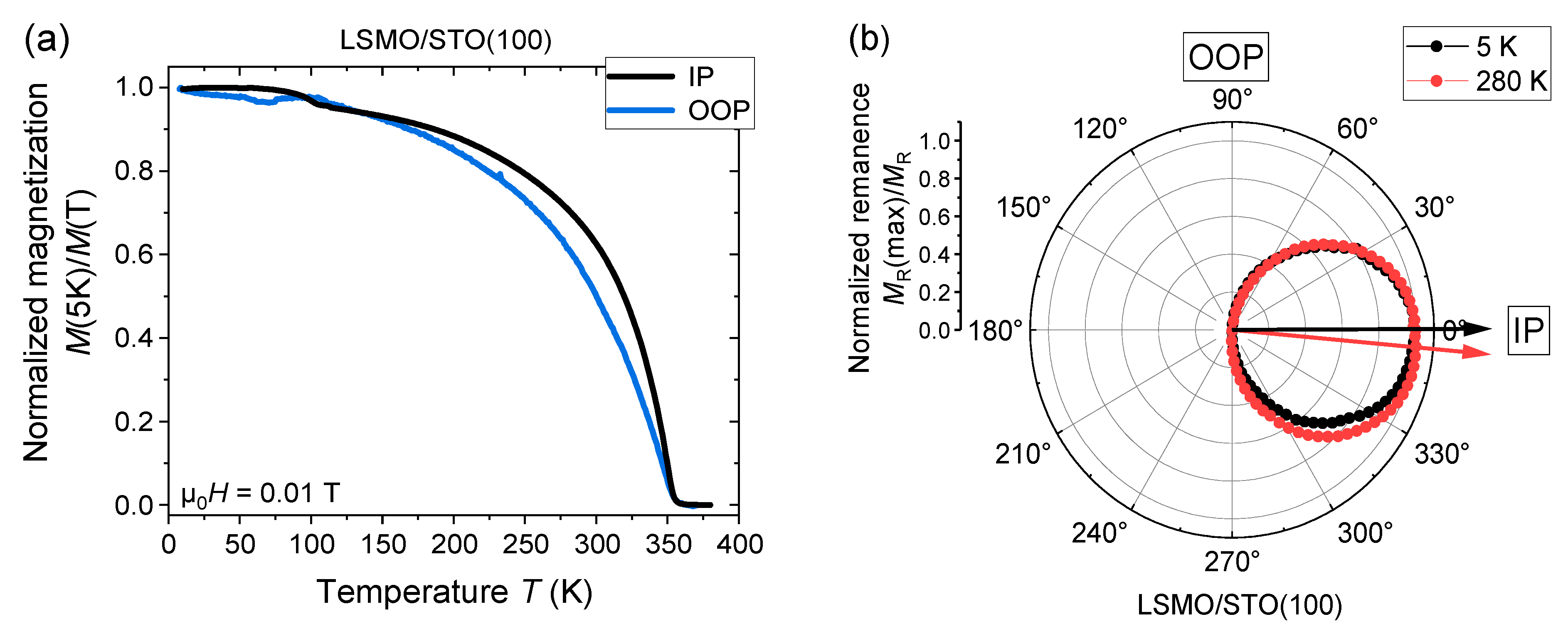
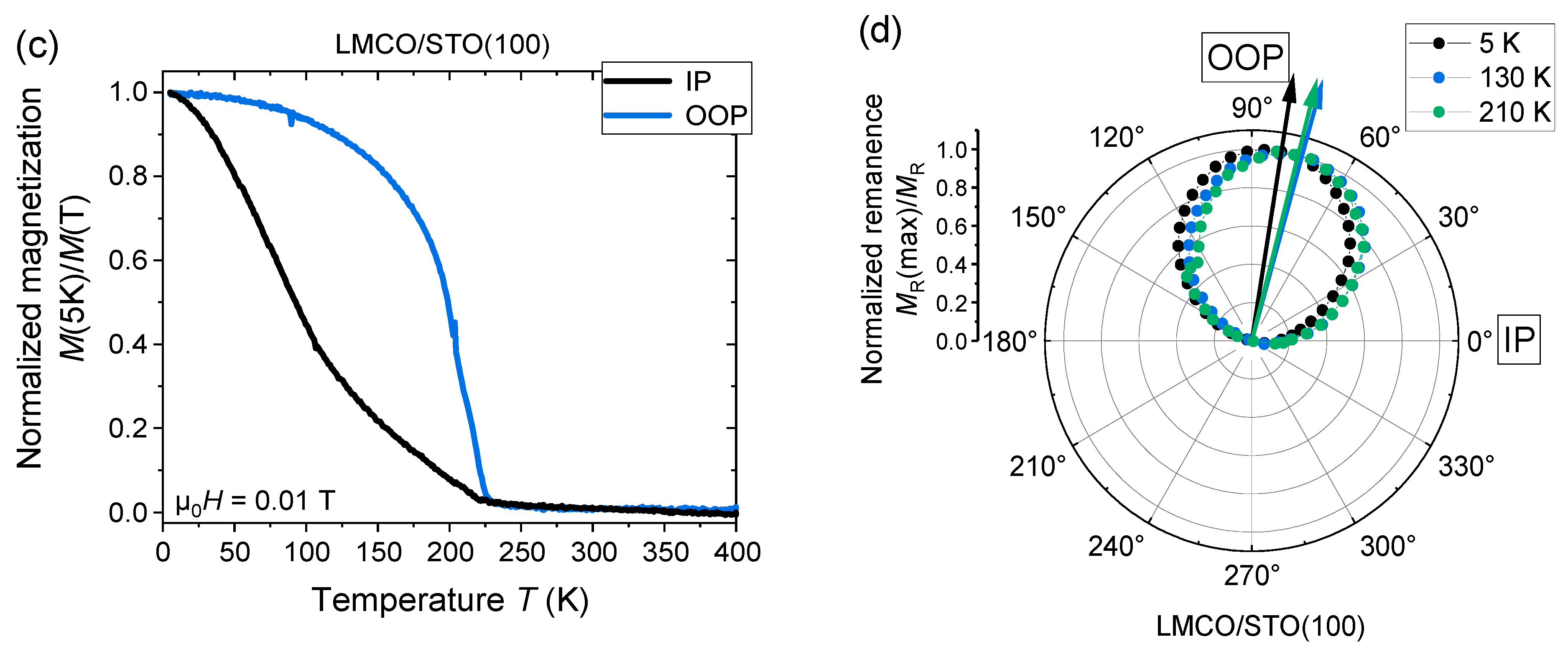

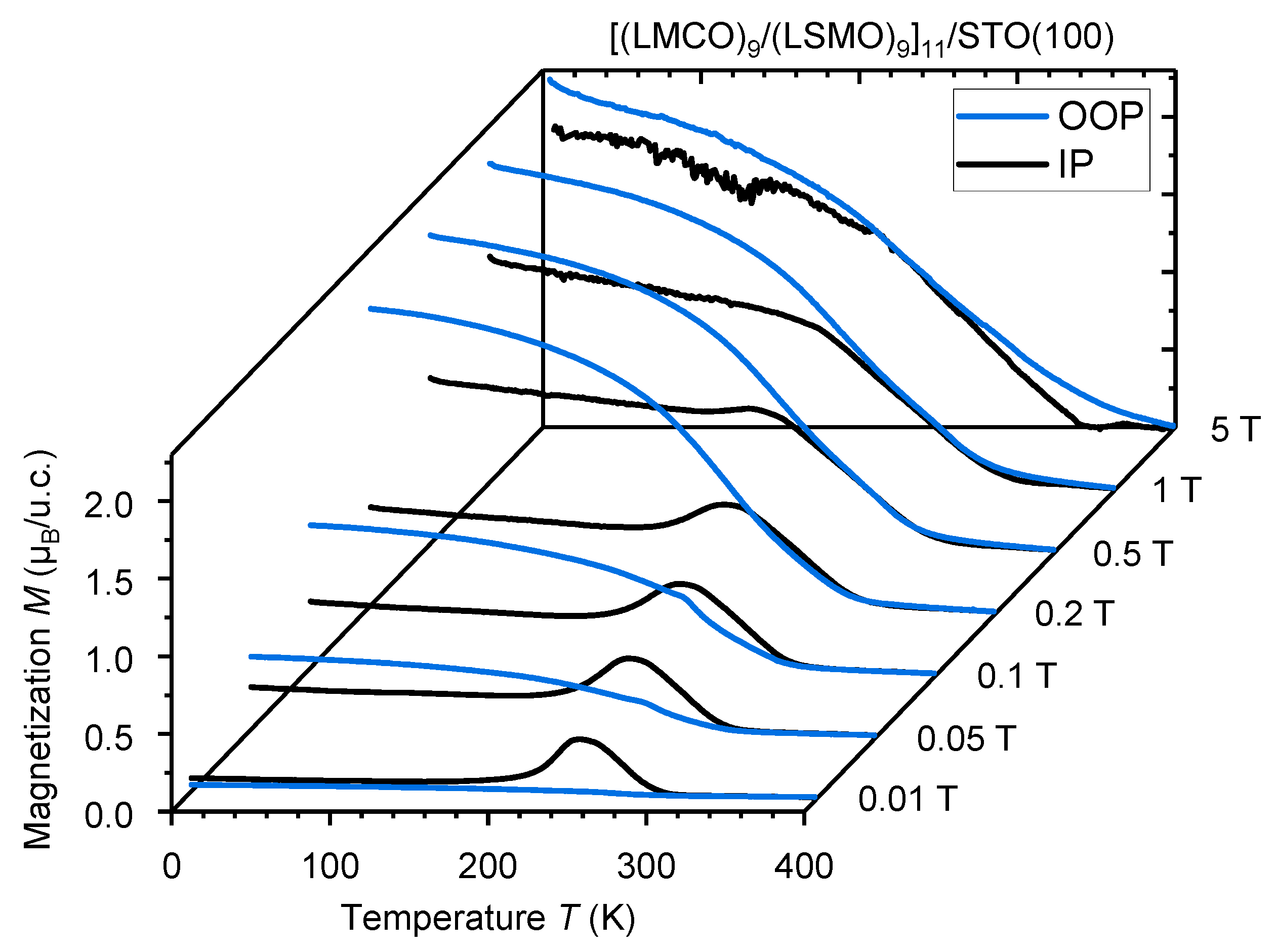

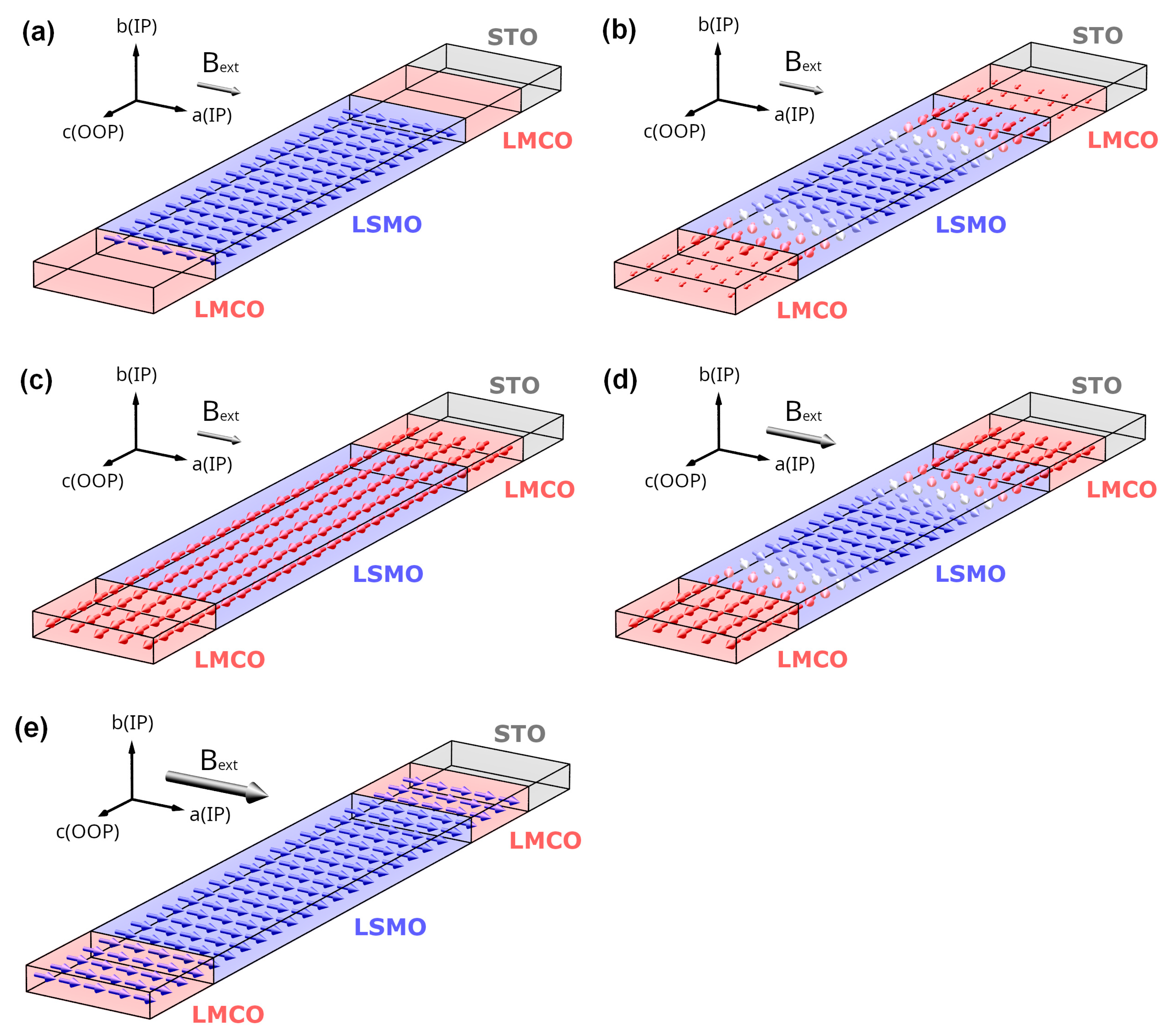
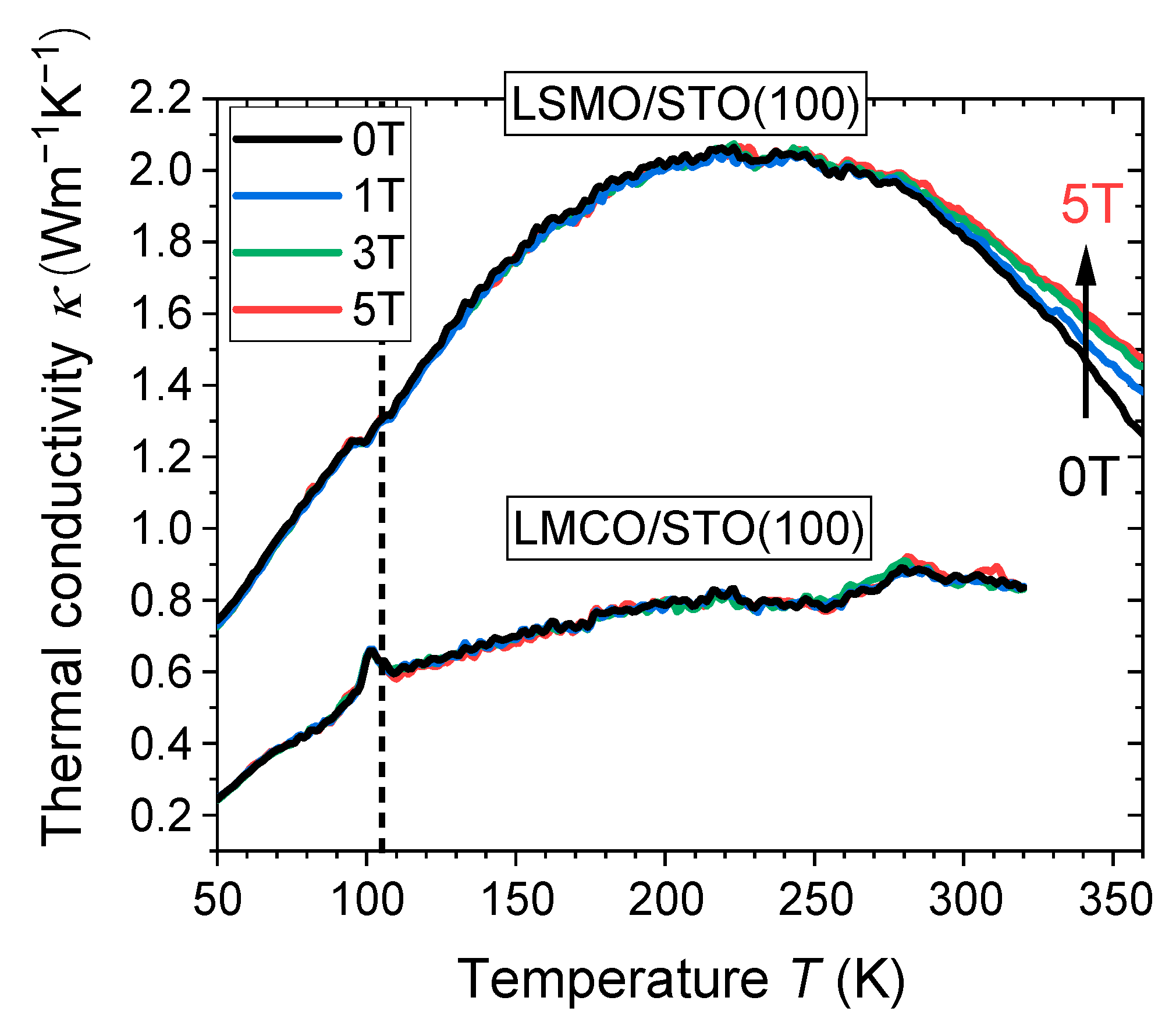
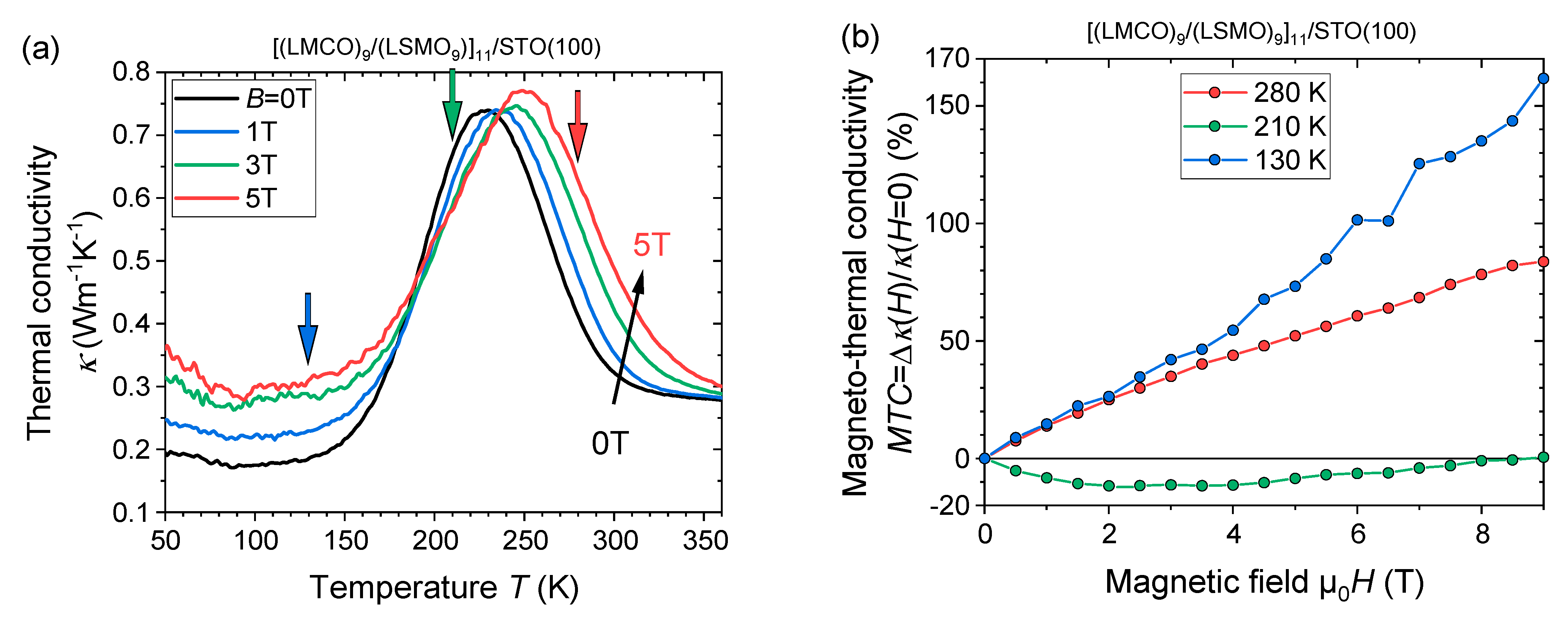
Disclaimer/Publisher’s Note: The statements, opinions and data contained in all publications are solely those of the individual author(s) and contributor(s) and not of MDPI and/or the editor(s). MDPI and/or the editor(s) disclaim responsibility for any injury to people or property resulting from any ideas, methods, instructions or products referred to in the content. |
© 2023 by the authors. Licensee MDPI, Basel, Switzerland. This article is an open access article distributed under the terms and conditions of the Creative Commons Attribution (CC BY) license (https://creativecommons.org/licenses/by/4.0/).
Share and Cite
Bruchmann-Bamberg, V.; Weimer, I.; Roddatis, V.; Ross, U.; Schüler, L.; Stroh, K.P.; Moshnyaga, V. Magnetism and Thermal Transport of Exchange-Spring-Coupled La2/3Sr1/3MnO3/La2MnCoO6 Superlattices with Perpendicular Magnetic Anisotropy. Nanomaterials 2023, 13, 2897. https://doi.org/10.3390/nano13212897
Bruchmann-Bamberg V, Weimer I, Roddatis V, Ross U, Schüler L, Stroh KP, Moshnyaga V. Magnetism and Thermal Transport of Exchange-Spring-Coupled La2/3Sr1/3MnO3/La2MnCoO6 Superlattices with Perpendicular Magnetic Anisotropy. Nanomaterials. 2023; 13(21):2897. https://doi.org/10.3390/nano13212897
Chicago/Turabian StyleBruchmann-Bamberg, Vitaly, Isabell Weimer, Vladimir Roddatis, Ulrich Ross, Leonard Schüler, Karen P. Stroh, and Vasily Moshnyaga. 2023. "Magnetism and Thermal Transport of Exchange-Spring-Coupled La2/3Sr1/3MnO3/La2MnCoO6 Superlattices with Perpendicular Magnetic Anisotropy" Nanomaterials 13, no. 21: 2897. https://doi.org/10.3390/nano13212897
APA StyleBruchmann-Bamberg, V., Weimer, I., Roddatis, V., Ross, U., Schüler, L., Stroh, K. P., & Moshnyaga, V. (2023). Magnetism and Thermal Transport of Exchange-Spring-Coupled La2/3Sr1/3MnO3/La2MnCoO6 Superlattices with Perpendicular Magnetic Anisotropy. Nanomaterials, 13(21), 2897. https://doi.org/10.3390/nano13212897






